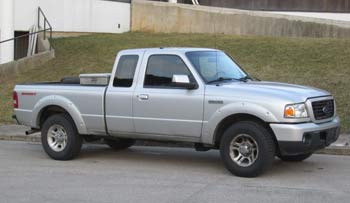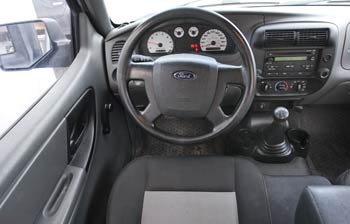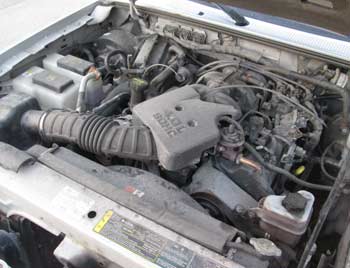1998-2011 Ford Ranger: common problems, engines
By Vlad Samarin March 27, 2020
The Ford Ranger is a solid small truck that can do a lot of work. You can get a sporty two-door Regular Cab (standard) or two- or four-door SuperCab (extended cab) with a longer wheelbase.
Regular Cab is available with a 6- or 7-foot bed. Super Cab offers two small fold-out jump seats in the back, although space is limited.
The Ranger comes in a 4x2 or 4x4 configuration, with a manual or automatic transmission. The Ford Ranger is simple, old-school and easy to work on and there is a lot of room for modifications. Parts are widely available and not very expensive. With good care, the Ranger can outlast many modern vehicles. What are the reported problems?
Reported problems:
A leaking plastic thermostat housing in the 4.0L SOHC V6 is pretty common. Symptoms include overheating, coolant smell coming from under the hood and the coolant seeping in the front center portion of the engine. If not repaired in time, overheating can cause more problems. The thermostat housing parts are not expensive. You will likely need a few extra parts, such as the temperature sensor O-ring, coolant, etc. Several owners have reported changing the plastic thermostat housing more than once, so using a good quality part will pay off in the long run. We even found an aluminum thermostat housing sold on eBay. Doing this job in a repair shop will cost from $250 to $450, depending on the parts replaced. There are plenty of YouTube videos describing this problem and repairs.If you are buying a used Ford Ranger with a 4.0L SOHC engine, try starting the truck when the engine is cold and watch out for a rattling noise. Watch these videos describing the problem and repairs.
Chirping noise in a 3.0L OHV V6 or 4.0L OHV V6 can be caused by a dry camshaft synchronizer. It can be either lubricated temporarily or replaced; the part is not very expensive. We found many YouTube videos explaining the problem.
A bad or sticky IAC (idle air control) valve can cause idle problems, but it's not very expensive and is easy to replace.
Intake vacuum leaks are also pretty common in many Ford engines. Symptoms of a vacuum leak include rough, unstable idle, stalling when coming to a stop and sometimes the trouble codes P0171 and P0174 (lean air fuel mixture). Sometimes a vacuum leak, such as a cracked vacuum pipe or elbow, can be detected by a hissing noise under the hood. Often, problems are caused by bad intake manifold gaskets that are more difficult to diagnose. Mechanics use what they call a "smoke machine" to find an intake vacuum leak. We also found many YouTube videos on this subject.
Rusted/broken leaf spring hangers and shackles can cause the rear of the vehicle to feel "loose." This problem is more common in the rust belt. Parts are cheap, but replacing them could be labor intensive, especially if badly rusted. Watch these videos.
A bump, thud or clunk when coming to a stop can be caused by a sticking slip yoke of the drive shaft. Greasing it usually solves the problem. It's a very common issue in many 4WD or RWD trucks. This thread at Ranger-Forums.com discusses it.
There are also quite a few YouTube videos on the 5R55 transmission repairs. The transmission fluid must be changed in regular intervals. Many owners suggest changing the transmission fluid and filter at least every 60,000 miles to keep it clean.
One of our friends reported a problem with the blue turn signal flasher relay located under the left side of the dash buzzing continuously. The buzzing stops when the turn signal is activated. This problem could be caused by several reasons. The ground must be checked at the relay as a bad ground wire connection in the splice or at the bolt under the driver's seat could also cause this issue. Our friend found that the buzzing stopped after he cleaned inside the multifunction switch with an electrical contact cleaner spray. He later replaced the multifunction switch as a precaution.
Engines:
The 2.5L LL25 "Lima" inline-4 SOHC was available from 1998. It has a timing belt, but otherwise it is simple and easy to work on. For 2001 it was replaced with a 143-hp 2.3L 4-cylinder DOHC (only available in 4x2 trims). The 2.3L DOHC is a very good reliable Mazda motor; it has a timing chain.The 148-hp 3.0L OHV V6 (Vulcan) was available through 2008 model year. It's thirsty and doesn't offer much extra power compared to the 2.3L 4-cylinder. Coolant leaks from the front (timing) cover are not uncommon; watch this video. There were some issues with the valve seats causing misfiring and problems caused by overheating; but other than that it's a solid old-school motor that can last long with good care. Keeping the coolant level topped up will help prevent overheating.
The 1998-2000 Ranger offered a 245-hp 4.0L OHV V6 "Cologne" engine. It is a pretty good motor with plenty of power at low rpms, but it's thirsty and doesn't like overheating.
For 2001, it was replaced by a 4.0L SOHC V6, the most commonly available motor. Earlier years had issues with timing chains and hardware, but later years are better. It is not very good on gas, but if the timing chain components are in good shape, it can last long if maintained well.
4WD System: The Ford Ranger comes with a part-time 4WD system. In a part-time 4WD system, the transfer case rigidly connects the front and rear axles when 4x4 engaged. For this reason, a part-time 4WD should not be used on a dry pavement; check the owner's manual for details. Ford offered an optional manual transfer case on some earlier FX4 trims, but we only found one 2003 Ranger with a manual transmission and manual transfer case in all the U.S. Most of the 4WD Rangers come with an electronic shift 4WD (2H 4H 4L). This post at TheRangerStation.com provides many interesting details. An optional rear limited-slip differential was available in some model years in V6 trims; it's a good option if you often drive on snow-covered roads. Some FX4 trims came with an optional Torsen rear differential. In terms of 4WD maintenance, axle seals, drive shafts, U-joints, front CV axles and other 4WD components must be regularly inspected. The gear oil in the front and rear differentials as well as the fluid in the transfer case need to be checked periodically and changed when dirty.
What to look for when buying a used Ford Ranger: If you want to buy a used Ford Ranger, look for the 2005 and newer model years. We like the 2.3L 4x2 Ranger with a manual transmission because it is frugal, fun to drive and is one of the most fuel-efficient pickup trucks with an EPA rating of 22/27 mpg city/highway (2010, 2011). The 4.0L SOHC V6 is thirsty, but can last long with good care. As of March 2020, Consumer Reports rated the 2007, 2009 and 2011 Ranger 'above average' for reliability, although 'Transmission Minor' is marked as trouble spots. Given the reports of coolant leaks, it's important to keep the cooling system topped up and timely fix cooling system problems. Rustproofing will help protect the frame and undercarriage.
When test driving a used Ford Ranger, watch out for any irregularities with the automatic transmission, such as delayed engagement, shift flare, slipping and harsh shifting. Sometimes a delayed engagement is more obvious when shifting into reverse. Before purchasing the vehicle, have it inspected by an independent mechanic. The condition of the frame, brake lines, ball joints and other underneath components is very important, especially if the truck came from the rust belt. Ask to check for leaks carefully. Check the NHTSA website for recalls.


